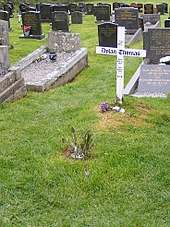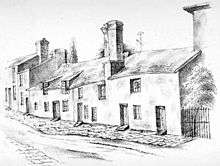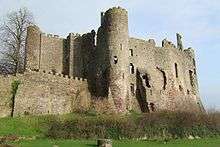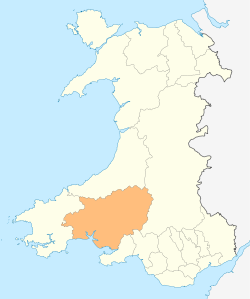Laugharne
Laugharne
| |
|---|---|
.jpg) Laugharne from the castle | |
 Laugharne Laugharne shown within Carmarthenshire | |
| OS grid reference | SN301109 |
| Community | |
| Principal area | |
| Ceremonial county | |
| Country | Wales |
| Sovereign state | United Kingdom |
| Post town | CARMARTHEN |
| Postcode district | SA33 |
| Police | Dyfed-Powys |
| Fire | Mid and West Wales |
| Ambulance | Welsh |
| EU Parliament | Wales |
Laugharne /ˈlɑːrn/ (Welsh: Talacharn) is a town located on the south coast of Carmarthenshire, Wales, lying on the estuary of the River Tâf.
Laugharne is within the electoral ward and community of Laugharne Township (Welsh: Treflan Lacharn) The population at the 2011 census was 1,222.[1]
The ward includes Laugharne, the village of Pendine and Pendine Sands. It was the civil parish corresponding to the marcher borough of Laugharne. A predominantly English-speaking area, just south of the Landsker Line, it is bordered by the communities of Llanddowror, St Clears, Llangynog and Llansteffan.
Laugharne was the home of Dylan Thomas from 1949 until his death in 1953, and is thought to have been the inspiration for the fictional town of Llareggub in Under Milk Wood, though topographically it is more similar to New Quay where Thomas mostly lived whilst he wrote the story.[2]
History
In the early 12th century, grants of lands were made to Flemings by Henry I when their country was flooded, and later they were joined by Flemish soldiers banished by Henry II.[3]
A castle, known originally as the Castle of Abercorran, existed in Laugharne before the Norman Conquest and belonged to the princes of South Wales. Henry II visited it in 1172 on his return from Ireland and made peace with Prince Rhys of Dinefwr. Through the marriage of Prince Rhys' daughter, the castle passed to Sir Guy de Brian, who had been Lord High Admiral of England. His daughter Elizabeth inherited the castle and married Owen Laugharne of St. Bride's who gave his name to the castle.
Possession passed to the Crown, and during the 16th century it belonged to Sir John Perrot, returning to the crown after his death. In 1644 the castle was garrisoned for the king and taken for Parliament by Major-General Rowland Laugharne, who subsequently reverted to the king's side. This led Cromwell to lay siege to the castle, leaving it in ruins.
Landmarks
Attractions in the town include the 12th-century Laugharne Castle,[4] the town hall and the birdlife of the estuary.
Laugharne contains many fine examples of Georgian townhouses, including "Great House" and Castle House, both grade II* listed buildings, with a scattering of earlier vernacular cottages.[5]
There are a number of landmarks in Laugharne connected with the poet and writer Dylan Thomas. These include: The Boathouse, where he lived with his family from 1949 to 1953, and now a museum; his writing shed; and the Dylan Thomas Birthday Walk, which was the setting for the work Poem in October.[6]

Laugharne Corporation
Laugharne Corporation is an almost unique institution and, together with the City of London Corporation, the last surviving mediæval corporation in the United Kingdom. The Corporation was established in 1291 by Sir Guy de Brian (Gui de Brienne), a Marcher Lord. The Corporation is presided over by the Portreeve, wearing his traditional chain of gold cockle shells, (one added by each portreeve, with his name and date of tenure on the reverse), the Aldermen, and the body of Burgesses. The title of portreeve is conferred annually, with the Portreeve being sworn in on the first Monday after Michaelmas at the Big Court. The Corporation holds a court-leet half-yearly formerly dealing with criminal cases, and a court-baron every fortnight, dealing with civil suits within the lordship, especially in matters related to land, where administration of the common fields is dealt with. The Laugharne open field system is one of only two surviving and still in use today in Britain. The most senior 76 burgesses get a strang of land on Hugden for life, to be used in a form of mediaeval strip farming.
Customs associated with the Corporation include the Common walk (also known as beating the bounds), which occurs on Whit Monday every three years. This event is attended by most of the young and firm local population, their number swelled by many visitors. The local pubs open at approx 5.00 in the morning, and following a liquid breakfast the throng commence a trek of some 25 miles around the boundaries of the Corporation lands. At significant historical landmarks a victim is selected to name the place. If they cannot answer, they are hoisted upside down and ceremonially beaten three times on the rear.
Laugharne Corporation holds extensive historical records.[7]
Charter of Laugharne
The Charter of Laugharne came about during a tempestuous time in local Welsh history. Henry II (Plantagenet) held a parley with Rhys ap Gruffydd at Laugharne Castle in 1172. After Henry’s death, Rhys seized St. Clears, Llanstephan and Laugharne, and then lost them again to the crown. In 1215 Llewelyn ap Iorwerth (Llewelyn Mawr) Prince of Gwynedd, renewed the offensive for the Welsh and razed the three strongholds to the ground. King John in the last year of his reign (1216) restored Norman authority and granted the Lordship of Laugharne to Gui de Brienne who had espoused the daughter of the Lord Dynefor. It was de Brienne who granted Laugharne its famous Charter, and it was ratified by Edward I, at some time between 1270–1290. The Charter reads,
To all the faithful in Christ, to whom this present writing shall come, Gwydo de Brione, the younger [wishes] eternal salvation in the Lord. Let all of you know that we have granted to our beloved and faithful burgesses of Thalacharn, for us and for our heirs and for our successors, whoever they may be, all the good laws and customs that the burgesses of Carmarthen have up to now used and enjoyed in the time of King John, the grandfather of the Lord Edward I, the son of Henry III, and their predeccessors, Kings of England; preserving the weights and measures that were in the time of Gwydo de Brione, the elder.
We have also granted to the same men a free common in all our northern wood, that is to say, in the whole forest of Coydebech, and all that common pasture in the marsh of Thalacharn which is called Menecors along the marks and boundaries as it is perambulated, and also all that free common from the rivulet which is named Mackorellis on proceeding upwards as far as Greensladeshead, and so towards the east over Eynonsdown by the way that leads to Brangweys, and from there to Corranshead and so upwards to Horilake and from there to the top of Tadhill, and so downwards to Passenant’s Lake and so towards the east to the bounds between Moldhill and that carrucate of land that formerly belonged to Rice, the son of William and downwards to the water of the Taf and so to Heming’s well and from there upwards to Horestone and so to Pensernes and from there downwards to Blindwell and so to Rochcomb and so downwards to the ancient whirlpool of the Taf and from there to Howelscroft and so upwards to the Burch and Mere, and so downwards to the long rock which is near our virgate of Thalacharn.
Also we have granted to the same men one way sixteen feet in which to drive their cattle from the common pasture aforesaid near Passenant’s lake to the water of the Taf.
Also we have granted to the same men one customary acre in length and breadth for digging turfs where they suitably wish to choose in the Turbary near Passenant’s Lake.
We have also granted to our burgesses aforesaid that they themselves for the transgression or forfeiture of their servants may not lose their own chattels and goods found in the hands of the servants or placed aside anywhere by the servants themselves within our land, as far as they will be able to prove that they are their own. And that, if the aforesaid burgesses, or some among them, within our land have died testate or intestate, neither we nor our heirs shall cause their goods to be confiscated so that their heirs do not have the things themselves entirely, as far as it will be established that the aforesaid chattels were those of the said deceased, provided that then knowledge or confidence may be had concerning the aforesaid heirs.
Also we have granted to the same men that no one of them within our land be troubled for the debt of some neighbour, unless he be his debtor or his surety, and that the surety of any one should not be compelled to pay, provided the debtor has wherewith he can pay, and that all off ences committed within their township be corrected according to the judgment of the same people, as has hitherto been accustomed to be done in the borough of Kymarden. We have also granted to the same men, if anyone of them within his township shall have incurred forfeiture towards anyone, he may not be led within the gates of the castle, provided that then he can find good and safe sureties for his standing trial. And that no one of them be compelled to provide his lord, or any bailiff of his, beyond twelve pence, unless he wishes to do it of his own good will, and that no inquisition of affairs of non-burgesses be made by the aforesaid burgesses, but by the freeholders of the country, nor of the burgesses by non-burgesses.
Also we have granted to the same our burgesses that they themselves choose twice in a year two competent burgesses to the office of our Port- reeve, that is to say one in the next hundred-court after the feast of Saint Michael, the other in the next hundred-court after Easter, by the common consent of the same men and not by our authority or that of someone, a bailiff of ours, to hold the hundred-court and to receive the attachments belonging to the hundred and to receive the rent from the township and the toll. And that the said portreeves pay the aforesaid rent and toll to us or to our aforesaid bailiff, appointed for this purpose, within the township of Thalacharn by Tally.
And that they should not have any other duty of buying of exchange, or any other service whatsoever that could harm them within the township or without.
We have also granted to the same men that the aforesaid burgesses be free from every kind of servitude and service of ploughing, harrowing, making hay, reaping, binding corn and of any kind of carting, of repsiring the mill or its pond and from all other kinds of services that could tend to their slavery or their loss within the township and without.
And that they go not to the army except to guard their township, as the burgesses of Kymarden do.
We wish also and grant that, if any one in the open day, in the presence of his neighbours, should buy anything, and afterwards that thing should be ill-spoken of, as if stolen, the buyer lose nothing except then that thing, but it shall he sworn on the oath of his neighbours that he did not know that he had bought that thing from a thief.
And, that this our grant and the confirmation of our present charter for us and for our heirs and for our successors or assigns, whoever they may be, should remain firm and unshaken for ever, we have strengthened this present charter with the impression of our seal, these men being witnesses. Galfrid de Caunville, Patrick de Cadure, William de Caunvill, Thomas de Roche, Roger Corbet, knights. John Laundry, Walter Malenfant, Mared ab Traharn, Thomas Bonegent, clerk, and others.
Notable residents

- Bridget Bevan, known as Madam Bevan, was an educator, who was the main benefactor to the work of Griffith Jones, the father of the modern schooling system in Wales. She died at Laugharne in 1779.
- The clergyman and one-time Dean of Gloucester Josiah Tucker was born at Laugharne in December 1713.
- The author and traveller James Augustus St. John was born at Laugharne on 24 September 1795.
- The Australian pastoralist and politician Arnold Wienholt, Sr. was born at Laugharne on 22 January 1826.[8] His brother Edward Wienholt, another Australian politician, was also born at Laugharne, on 28 March 1833.[9]
- The nun, Mother Agnes Mason was born at Laugharne on 10 August 1849.[10]
- Joseph Arthur Hamilton Beresford, Australian naval commander, and hero of the capture of German New Guinea during the Great War, was born at Laugharne in 1861. His son, Arthur Edward Bathurst Beresford, was killed in France during the Great War.
- The first Welsh soldier to win the Victoria Cross during the Great War of 1914–1918, Private William Charles Fuller, VC of the 2nd Battalion, Welsh Regiment, was born at Newbridge Road, Laugharne on 13 March 1884.
- The one-time director of the Johnson Space Centre George Abbey is the son of Bridget Gibby, of Laugharne. Bridget was working in London when she met George's father, Sam Abbey, and the couple married before moving to Seattle, where George was born on 21 August 1932.
- Poet Dylan Thomas lived in Laugharne – in rented accommodation – from early 1938 to July 1940, then returned in May 1949 to live with his family in the Boat House until his death in 1953. He is buried in Laugharne churchyard.
- Gary Pearce was one of the outstanding outside halves in Wales during the early 1980s, playing for Laugharne, Bridgend, Llanelli and Wales, before turning professional with Hull KR. He was born at Laugharne on 11 November 1960.
During the Great War, over 300 men and women of Laugharne and surrounding villages volunteered to fight in His Majesty’s Forces, 54 of these lost their lives. They are buried or commemorated all over the world, from Belgium to India. In World War II a further 20 men were lost from Laugharne. These men, alongside their compatriots from Carmarthenshire, are remembered in perpetuity on the website West Wales War Memorials
Laugharne weekend
Laugharne hosts a three-day arts festival in the spring, the Laugharne Weekend. The festival's inauguration was in 2007, featuring writers such as Niall Griffiths and Patrick McCabe. Headline performers since then have included Ray Davies, Will Self, Howard Marks and Patti Smith. Although the town's Millennium Hall was used as the main venue, smaller events were hosted by local venues including Dylan Thomas's Boathouse.[11]
References
- ↑ "Community population 2011". Retrieved 28 November 2017.
- ↑ "Under Milk Wood – A Chronology". Dylan Thomas The Official Website. The City and County of Swansea. 2015. Retrieved March 22, 2016.
- ↑ R.H. Tyler; et al. (1925). Laugharne, Local History and Folklaw. Gomer Press, Llandysul, Dyfed.
- ↑ "Laugharne Castle". Visit Wales. The Welsh Government. Retrieved March 22, 2016.
- ↑ "Listed Buildings in Laugharne Township, Carmarthenshire, Wales". British Listed Buildings. Retrieved 20 December 2013.
- ↑ "Dylan Thomas' Laugharne". Visit Wales. The Welsh Government. Retrieved March 22, 2016.
- ↑ Carmarthenshire Archives Service website
- ↑ Waterson, D.B. "Wienholt, Arnold (1826–1895)". Australian Dictionary of Biography, Online Edition. Canberra: Australian National University. ISSN 1833-7538. Retrieved 27 May 2011.
- ↑ Waterson, D.B. "Wienholt, Edward (1833–1904)". Australian Dictionary of Biography, Online Edition. Canberra: Australian National University. ISSN 1833-7538. Retrieved 27 May 2011.
- ↑ Julia Bolton Holloway, ‘Mason, (Frances) Agnes (1849–1941)’, Oxford Dictionary of National Biography, Oxford University Press, 2004 accessed 12 Nov 2016
- ↑ Laugharne Weekend website
The Laugharne Corporation now has its own official web site which gives more details about the town and can be found by visiting http://www.laugharne.info

